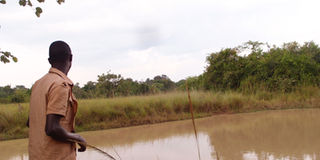Prime
When crocodiles camp and terrorise villages

Paul Aleper, a herdsman shows the writer a dam in Nakayenje village, where the crocodile that has been eating livestock and goats is believed to have camped. Photo by Christine W. Wanjala.
What you need to know:
In the past few months, there have been reports of crocodiles eating up livestock and attacking people. Residents in these areas live in fear and yet they fill they have no option as the reptiles stay in the only water sources in the areas.
“A crocodile in my farm in Migeera-Nakasongola has eaten two adults, a child, 10 of my goats and a dog, but my relentless cry to the Uganda wildlife Authority for help has not been fruitful. How serious should i sound to get help?”
This was the message of desperation Bernard M. Ssesanga sent to the Daily Monitor. When I was given an assignment to follow up on this, my first thoughts were, “Crocodile on his farm? Does it live on land, in a pond? Is his farm by a river, or a crocodile farm, or a game park? How long has this been going on? How big is the crocodile and how does snatch the animals and people?”
The answer lay in Migera, about 120Km from Kampala at the farm Ssesanga talked about.
Paul Aleper, a herdsman at a farm belonging to Ssesanga, had his own story to tell. It was a few minutes past noon and he had taken the goats in his care to drink water.
“I was standing there, by the water when it hit. There was a great splash, water everywhere and one goat was gone!” he says.
The ‘it’ he refers to is the crocodile, the one that he says has been plaguing Nakayenje village in Migera, Nakasongola District. That was the first time Aleper saw the crocodile take a goat and in the four or five months since then, he says it has taken five more and a dog. The dog was grabbed at the beginning of August. He narrates, “We were standing by the dam, the boy who had come to fetch water and I. The dog had followed the boy and was sniffing around the water, when there was another splash of water that sent the boy flying back into that grass,” Aleper points to a mound of grass about four feet from the dam’s edge where the shaken boy fell then continues, “Next thing we knew the dog was gone. We only collected the head of the dog later.”
What attracts the reptiles
To reach Nakayenje village, one takes a winding track through incredibly flat land dotted with shrubs. Every once in a while, we pass by a homestead or a herd of cattle grazing peacefully. We see a truck piled high with charcoal and a few boda bodas ferrying sacks of the same. It takes us 30 minutes to reach Nakayenje from Migera trading centre by boda boda. How long it would take one on foot is anybody’s guess. Even Aleper who spends his day wandering through the farmland admits it is quite a distance to the shopping centre.
Residents in the sparsely populated area are blessed with plenty of elbow space. Expansive lands perfect for grazing cattle. But with no hills or valleys, there are also no springs, streams or rivers. River Kafu is about 50kilometres away. So they dig big ponds that they call dams. During the rainy season when parts of the plains tend to flood, these dams fill with water. Over time, the dams have become sort of permanent features, getting deeper by the year and lasting through the dry season. The dams provide water for the animals and for home use, which solves the water problem in the area.
“Almost every farm has a dam,” explains Geoffrey Khaweka who assists as a farm manager for Ssesanga. It is also these dams that the crocodiles have chosen to make a home and from where they have become a menace snatching goats from time to time.
We are able to visit several dams in the space of one hour, two within 10 minutes’ walk of each other and one a little farther off and much older looking. Surrounded by trees, the dams look like havens of peace. Surely nothing sinister could lurk under the shallow looking water.
Aleper says that assumption is the reason the crocodile’s attacks are so successful. “It lies in wait while we go about our business oblivious of its presence. The crocodile never takes a thin goat, always the fat ones,” he adds.
He believes there could be one crocodile plying the two dams that are close to each other. “Sometimes it is here, and other times there,” he says pointing to the other dam. He and Ben Ssesang,a a son to the farm owner who alerted us to the crocodile problem, accompany us to see the dams and maybe the crocodile. They think the crocodile moves at night. Or there are two crocodiles .They claim in the other dam there are two adult crocodiles and a few young ones. When we visit in the late afternoon we do not catch a glimpse of a crocodile but the residents are sure it is somewhere. “Sometimes at noon, you will find it lazing by the water,” says Aleper.
Esther Akiiki says she has lost 10 goats at the dam. “They go to drink water and it seizes them from there,” says the middle-aged woman, taking a break from cleaning her milk pots. She like the others does not know how the crocodiles came to be in their dams. “Maybe they came from dams in Minoni, they have many crocodiles there,” she says.
She also supposes they could have moved from river Kafu, moving through the dams that tend to dot the area till they got to Nakayenje.
After the recent incident where the dog was grabbed as the boy was fetching water, Akiiki is a worried woman. More so because avoiding the dam is out of question. “What if it had gotten the boy? It is where we get all our water. For home use and for the animals, we cannot stay away, even if we wanted to,” she says.
Aleper and Khaweke echo her words. The milky looking water is the only one available for miles whether for drinking, cooking or washing. As we go to the third dam, one alleged to have more than one crocodile, we meet some children carrying jerry cans of water.
“As you can see, several families depend on the dams for survival. And you cannot tell where the crocodile is at any one time,” says Khaweka. None of them could confirm that the crocodile had taken or eaten people. Akiiki says “I heard that crocodiles took two small children but I heard it was far off, not around here.”
There is talk about a crocodile biting off a girl’s arm off, but that is a little far off on the banks of river Kafu. Oswald Tumanya, a ranger attached to problem animal control at Uganda Wildlife Authority (UWA) says, the crocodiles in Nakasongola area are not man eaters.
“The crocodiles in Luwero, Nakaseke and Nakasongola feed on livestock because the water they inhabit does not have enough fish,” says the ranger who has been involved in trapping crocodiles and other reptiles. The diet of a crocodile he says is primarily fish and the livestock is in the event their staple is not available but they do not see humans as food. This probably explains why the crocodile grabbed the dog and left the boy.
Tumanya confirms that indeed a crocodile can move from dam to dam provided the distance is less than a kilometre. This gives credence to the claims of the Nakayenje residents of the same crocodile dividing its time between two dams, or three dams. “Crocodiles are very good at smelling water, they can always tell in what direction the nearest water body is,” he says. On land the farthest a crocodile can move is around two kilometres and they are only likely to move that far when in search of a place to lay their eggs.
“The only other reason they leave the water is to sunbathe and that is not far from the water. Generally, they like staying near water so that in case of anything, they go back into the water,” says Tumanya.
Reports to UWA
Ssesanga says he had contacted UWA about the crocodile on his farm but had not gotten a response which led him to send an email to the Daily Monitor. The same week we visited Nakayenje we learnt an UWA team had been to the area and set traps in the three dams where residents had reported seeing crocodiles. A week later, UWA through its coordinator of Community Conservation Unit (CCU) Arthur Kule said, they had removed two crocodiles from the area and dispatched them to Murchison Falls national park. “I received positive feedback from the team on the field,” said Kule.
According to Kule, the department receives at least 50 reports like Sessanga’s a year from around the country. He says however, that only about half of these reports ever turn up anything. “People call us saying, ‘I have seen a crocodile’ all the time. On many occasions, we respond and find no crocodiles. We set traps and nothing,” he says.
Kule has no idea why people always report sighting crocodiles even when they are not there. “Maybe they see monitor lizards which move quite a lot on land, a big one looks like a crocodile,” he says. However, while a monitor lizard in water may be mistaken for a small crocodile, it would not take down a whole goat. “It would take two of them to eat a just one kid,” says Kule
On the matter of the department seemingly dragging its feet in responding to such as the case on Ssesanga’s farm where it had caused considerable loss over a period of time, Kule thinks it has to do with how speedily a person alerts UWA.
“We respond within 24 hours when we get a report. But people take their time to report. Sometimes one will wait for weeks, even months since they saw the animal to report,” he says. This means when his team gets there, it may not find the animal and is also not able to wait it out till the next sighting.
“Where there have been fatalities though, or in the instance of where livestock like in the Nakayenje cases is taken, we always find a crocodile,” he says. Kule shares that the CCU has picked up crocodiles from islands of Lake Victoria, parts of Mayuge District and Nakasongola and moved them to national parks.
Ssesanga was not aware of any crocodile(s) being removed from the dam in his farm. “I would need to confirm that,” he said when we inquired from him.
His farm manager Abdallah Aziz was also not aware. “I have not heard about it or seen anything,” says Aziz. He does not see the likelihood of a person driving through the farm without someone spotting it.
“It is unlikely that the crocodile was removed from the dam. Two, three days ago, two goats were snatched at the dam. We only found a few remains, some bits of entrails. The crocodile is still very much there!” he says.
-----
'A jerrycan saved me from the crocodile’s jaws'
April 16 is still fresh in the mind of Jacqueline Adong, a former pupil of Chakali Primary School in Ibuje Sub-county in Apac district. Adong, 16, who stays with her grandmother Mary Apala says, that day after school, she proceeded to get water for domestic use at home at about 3pm.
“As I entered the river to collect water, I realised that something had grabbed my hand and it was pulling me into the water. It was a crocodile. When the jerrycan in my hands got off, the crocodile chased it thinking that it was me,” Adong says.
Adong cried for help until some people who had come to collect water came to rescue her. Adong survived with a deep wound on her right hand and was taken to Lacor Hospital where she spent two months.
Flesh from the thigh was removed to fill the wound that was left on her arm after the crocodile attack. She was told to report to the hospital every month for review, but she cannot afford the monthly transport of Shs40,000 from Apac District to Lacor hospital.
“I stayed there for two months and was discharged. I was told to report to the hospital after every month for review but since I was discharged, I have never returned,” she says.
She was also advised to seek more assistance from Mulago hospital for further diagnosis on grounds that there might be worms that remained in her body.
Adong wants to go back to school, but has no one to pay her school fees. The little resources they had at home were sold to get her treatment.
“I am not sure of her next destination, I cannot afford her treatment and her education, yet in school she has been a promising child,” says Apala, adong’s martenal grandmother.
Residents of Chakali village, live in fear following a spate of attacks by the Nile crocodiles on people and livestock.
Since 2012, four people have been killed and six others severely injured by man-eating reptiles at Oding landing site in the same sub county.
The most recent incident was registered last week after it killed a fisherman identified as Denis Ongom. Last year, Ivan Adupa, Benon Katete and Benedict Ogwang, all pupils of Chakali Primary School.
“We have no choice, the very sites where we have lost our dear ones is where we have to fetch water, because there is no option. There are only two functioning bore holes in the area which cannot serve all of us,” Ms Cavin Akoli says.
Consantino Okao, LC3 Chairperson Ibuje, who also lost his 13-year-old son says, Uganda Wild Life Authority, has done nothing to help the communities, even mere support to the grieved families has never been received.
Officials from Uganda Wild Life Authority however, told the affected communities that they have mounted a search to catch the man-eating crocodile for relocation.
Bill Oketch
-----
[email protected]




